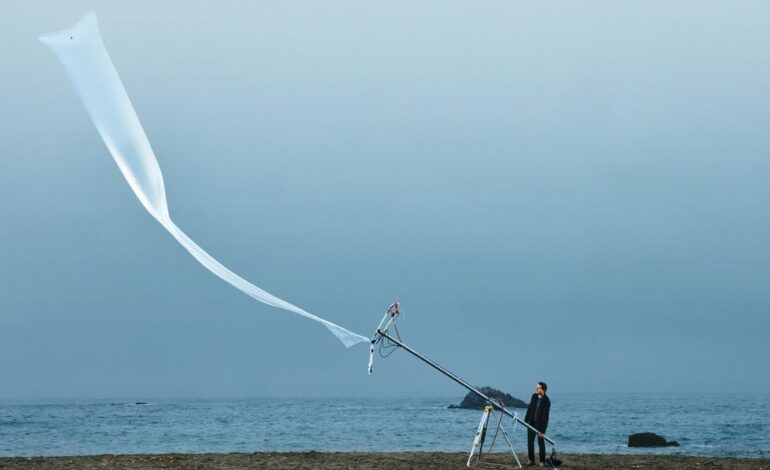WindBorne’s AI Balloons Revolutionize Hurricane Forecasting

In October 2024, Hurricane Milton emerged as one of the fastest-growing storms recorded over the Atlantic Ocean. Its rapid intensification caught meteorologists and affected communities by surprise, resulting in the loss of 15 lives and damage estimated at $34 billion as it ravaged Florida. The challenge in forecasting Milton’s explosive growth stemmed from a significant lack of reliable weather data typically gathered by flying specialized aircraft directly into storm systems.
To collect essential atmospheric measurements, human pilots often risk their lives to deploy dropsondes—sensors attached to parachutes that gather critical data. Unfortunately, aircraft can only conduct a limited number of missions, and many storms develop in regions that aircraft cannot safely access, such as the vast expanses of open ocean. As a result, data gaps exist in areas where the most dangerous weather phenomena begin.
WindBorne Systems, a company co-founded in 2019 by a group of Stanford University peers, is pioneering a new approach to weather forecasting. Their innovation includes advanced weather balloons and a proprietary AI forecasting system named WeatherMesh. Hurricane Milton presented WindBorne with its first opportunity to collect real-time data from a hurricane.
Innovative Data Collection with Global Sounding Balloons
Based in Palo Alto, California, WindBorne developed a sophisticated type of long-duration weather balloon known as Global Sounding Balloons (GSBs). These balloons can navigate through the atmosphere, leveraging wind currents to follow dynamic flight paths. In the lead-up to Hurricane Milton, WindBorne launched six GSBs carrying dropsondes from Mobile, Alabama. Within 24 hours, the balloons successfully entered the hurricane, releasing their dropsondes to measure temperature, pressure, humidity, wind speed, and direction—data that could have significantly improved forecasting accuracy.
This deployment marked the first instance of using weather balloons for dropsonde launches, demonstrating that airborne sensors can be released without jeopardizing human safety. When WindBorne analyzed the collected data using WeatherMesh, the model’s predictions for Milton’s trajectory proved more accurate than those from the U.S. National Hurricane Center. Unfortunately, as the deployment was an experimental endeavor, the results could not be shared with the public in real time.
WindBorne’s mission centers on creating what they call a “planetary nervous system,” an AI-based forecasting system that collects vast amounts of weather data to produce timely and precise forecasts. As climate change increases the frequency of extreme weather events like Hurricane Milton, better forecasting is essential for effective disaster preparedness.
Addressing the Limitations of Traditional Forecasting
The origins of WindBorne trace back to a project in the Stanford Student Space Initiative in 2015. The founders recognized that conventional weather balloons typically burst after a few hours, collecting data for only a limited time. These balloons rarely extend beyond their continental launch sites, leaving significant portions of the globe under-monitored.
Through their research, WindBorne’s team discovered that traditional weather balloons only observe approximately 15 percent of the Earth, which is insufficient for accurate global weather forecasting. The team sought to create autonomous balloons that could self-navigate and “surf” the wind, allowing them to remain aloft for weeks rather than hours.
In 2024, WindBorne introduced its AI forecasting model, WeatherMesh, designed to assimilate data from the balloons and provide high-level flight instructions to fill critical data gaps. Each GSB is constructed from a transparent film just 20 micrometers thick and weighs under 2 kilograms. The balloons can release ballast to adjust altitude or vent gas to navigate different wind currents.
WindBorne’s GSBs collect significantly more data than single-use dropsondes, forming the backbone of their global data collection network known as Atlas. Currently, these balloons can operate for over 50 days at altitudes reaching around 24 kilometers, collecting more in situ data daily than the U.S. National Weather Service.
Most weather forecasts rely on physics-based numerical weather prediction models, such as the Global Forecast System (GFS) in the United States. These systems require extensive computational resources and depend on data from satellites, ground stations, radar systems, and conventional weather balloons. However, the accuracy of these forecasts is limited by the sparseness of the data available; approximately 85 percent of the global atmosphere remains unmonitored.
AI forecasting models have emerged as a disruptive force in weather prediction, offering faster and more accurate forecasts. Following the introduction of models like Huawei’s Pangu-Weather and Google DeepMind’s GraphCast, WindBorne’s WeatherMesh has achieved recognition for outperforming these systems.
The development of WeatherMesh involved using advanced architectures, specifically transformers, to process vast datasets efficiently. The model was designed to be cost-effective and deliver high-resolution forecasts, crucial for effective decision-making in sectors such as agriculture and renewable energy.
By October 2025, WeatherMesh had proven itself as the most accurate AI forecasting model globally, achieving significant accuracy improvements compared to traditional physics-based models. Its ability to output forecasts at 0.25-degree resolution and provide real-time predictions marks a significant advancement in weather forecasting capabilities.
Looking ahead, WindBorne aims to expand its Atlas balloon constellation to approximately 10,000 GSBs operational at any given time by 2028. This expansion will involve around 300 launches daily from multiple global sites, providing extensive observational coverage.
WindBorne’s approach envisions a future where AI and traditional forecasting methods coexist, enhancing the ability of governments, researchers, and businesses to prepare for extreme weather events. With the ongoing challenges posed by climate change, the need for improved weather forecasting has never been more urgent.






